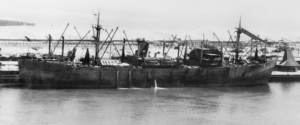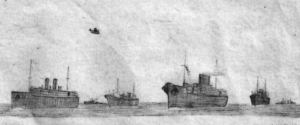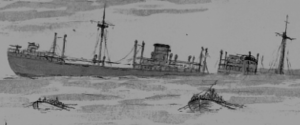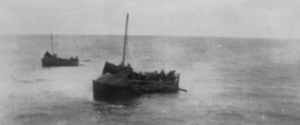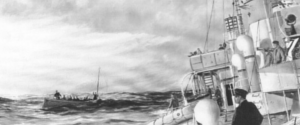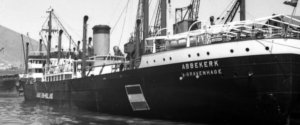Fremantle. Ready for another long voyage

30 March 1942. After a short journey Abbekerk again arrives at Fremantle. Here she bunkers and the last part of her cargo is being loaded. Bags of wheat destined for Ceylon en Persia.
By now the heavy Stanier 8F locomotives on board Abbekerk are starting to be a story in itself. In November in Britain the brand new locomotives were loaded. In Durban, some of them, the one’s loaded on deck, were unloaded. But as Abbekerk arrived in Fremantle there still were – as far as could be found out after the war- 5 to 8 Stanier 8F locomotives with tender on board. Because of their immense weight they were placed as deep as possible in the holds, distributed over the length of the ship and firmly secured. Everything to keep the ship as stable as possible. The space around them was used for the rest of the cargo, bombs and ammunition. All done safely and securely in Britain. But a lot happened after that and the locomotives have not escaped unscathed.
As said before, part of the cargo was unloaded in Durban, to get to the locomotives, and that was not handled delicately. And everything was thrown back in because of the hasty departure. In Singapore as well as in Oosthaven and Tjilatjap the holds were opened again and cargo unloaded from around the locomotives. In Fremantle the rest of the cargo around the locomotives was removed. In Bunbury we had to load these big heavy acetic acid holding beams. They had to go in the holds next to the locomotives. But, well, sometimes one wasn’t handled that well and accidentally pushed through one of the cabins ( of the loc’s). Then you heard the shattering of glass from the instruments and whatnot. Now back in Fremantle we had to load wheat. Wheat in bags destined for Colombo. But well… sometimes those bags tore. As a result one of the locomotive’s chimneys was filled to the brim with weath and also the cabin beneath it. It was a sad sight.
Third Mate Jacob Visser
Finally Abbekerk takes on board a few passengers to Colombo and so, a month after arriving in Australia, the ship is all set to deliver the locomotives at their final destination, 5500 miles away.
We were ordered to go to ‘Abadan’ in the north of the Persian Gulf. The first port of call was going to be Colombo on the Island of Ceylon (now called Sri-Lanka).This became a fairly long trip, going along the southern side of Java and the west Coast of Sumatra. The route was mostly set by the British Royal Navy, because they were aware of the latest maritime situation. Our people on the bridge would have preferred to have skirted these islands at a much greater distance. Luckily our trip went well.
Ass engineer Adriaan Kik

